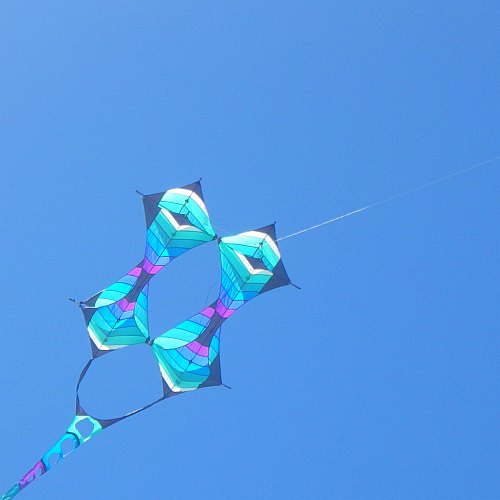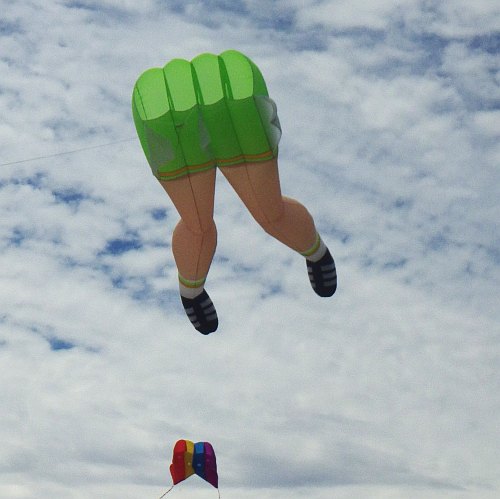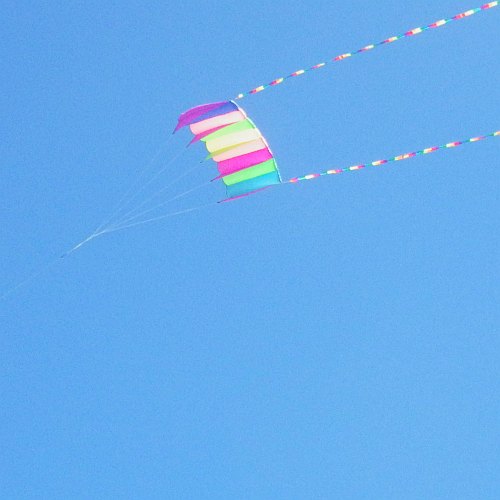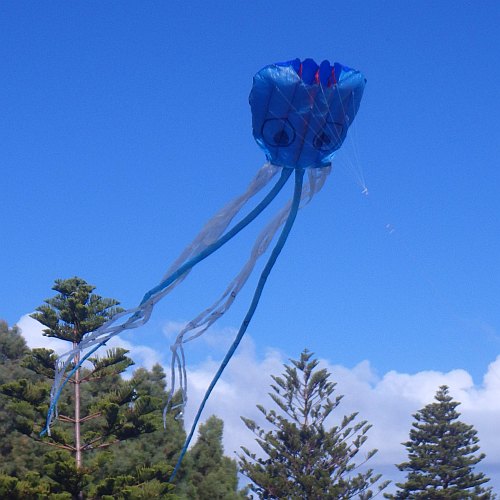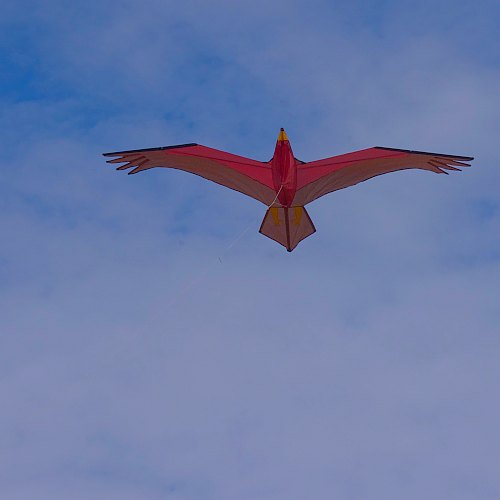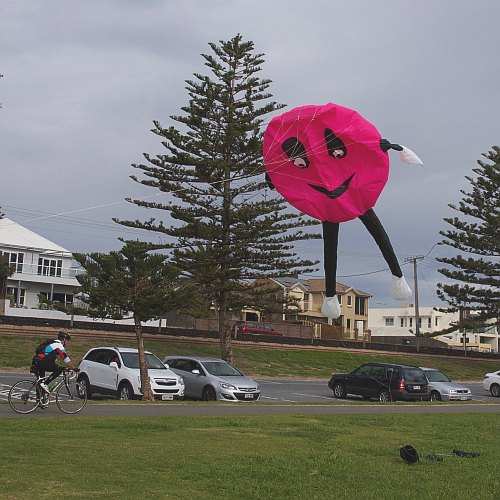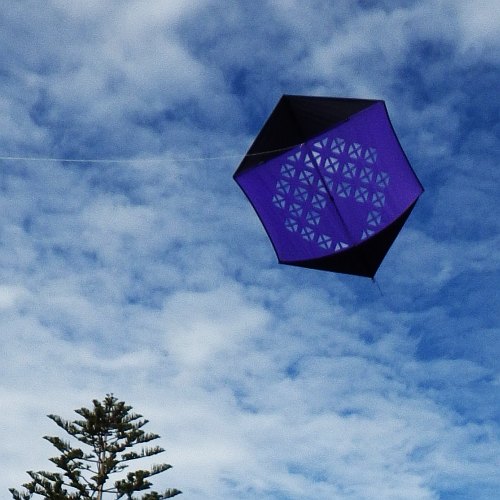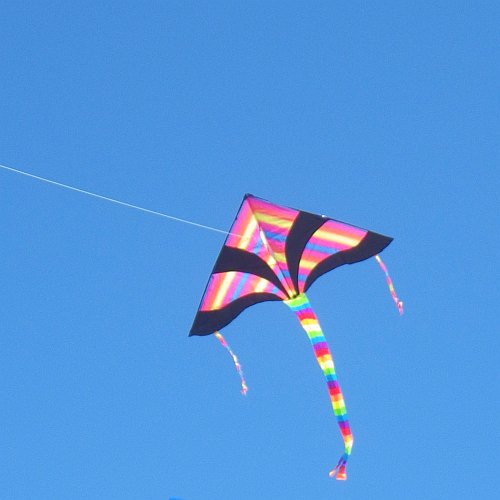AKFA Kite Fly Posts 2017
Adelaide Kite Flyers Association (AKFA). Every second Sunday of the month is a social fly day when (weather permitting) members meet to fly kites at Semaphore South.
These short flight reports once appeared in the site blog page although that blog is no longer being published. Just scroll down and stop at any kiting detail that appeals. :-) There's a photo gallery down near the bottom of this page too.
On this site, there's more kite-making info than you can poke a stick at. :-)
Want to know the most convenient way of using it all?
The Big MBK E-book Bundle is a collection of downloads—printable PDF files which provide step-by-step instructions for many kites large and small.
Every kite in every MBK series.
AKFA Kite Fly—December 2017
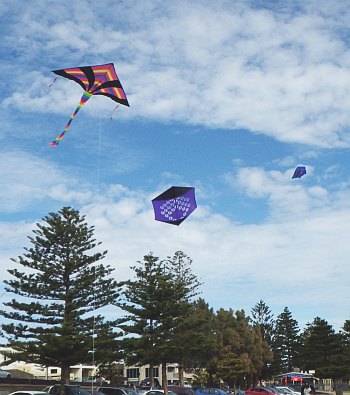 At the beach earlier in the year
At the beach earlier in the yearWarm, breezy, and sunny—that's how it often is at this time of year, far south of the equator.
The monthly club fly day at Semaphore South had a centerpiece of sorts. Mike had a big red pilot kite with an even bigger shark inflatable flying on the same line, just a few meters below. Thanks to a large toothy intake, the shark was apparently quite quick to inflate prior to launch. The same cannot be said for many other large inflatable designs that don't necessarily mimic something with a large mouth!
The rest of us put up smaller kites. But collectively, there was a decent display of floating color. The kites drew plenty of attention from people walking past or otherwise enjoying themselves on or around the grassed area.
There was a small parafoil with ribbon tail, a mid-sized but arty Brasington box, and a few slightly larger parafoils of various kinds. I had brought along my big Carbon Diamond and the Red Roller. However, with gusts reaching 28 kph, I decided to go with the MBK Parachute instead.
The plastic-and-tape parachute, which was based on photos of full-size skydiving 'chutes, was comfortable in the moderate-strength air. After all, it has flown successfully in 40-kph winds, albeit with a ribbon tail. Today, a small bridle adjustment was needed to stop the 'chute hanging off to the left.
Mike had a small green four-liner up for a few minutes. It was small by traction-kite standards, that is. The aerobatics were interspersed with soft trailing-edge landings on the grass. It was something of a workout, with plenty of wind power available up around 50 to 100 feet of altitude.
These days it seems there is nearly always someone somewhere flying a kite or two within sight on the beach. On this occasion it was a couple of "Bali kites." These were small ship kites that were flying steadily at very modest line angles over the sand. I took a photo, which by a fluke managed to include three seagulls very closeup in mid-flap!
So there was good flying and even better weather for the December kite fly last weekend.
AKFA Kite Fly—November 2017
At the local kite club's monthly outing last Sunday, we arrived to find several kites airborne in a rough light breeze from the south.
Apparently, everything had come to ground some minutes earlier. So was this going to be "one of those days" perhaps?
After wandering around for some time, taking photos, I rigged the big Multi-Dowel Delta on the grass and put it up.
The breeze had freshened somewhat, and the huge floppy light-wind delta took to flapping and flying off to one side then the other. This continued to happen even with a little drogue hanging off the back. There was just too much wind for a kite that is more at home wandering high overhead on a "light wind and thermals" kind of day. Less than ten minutes after launching, I took the big blue delta down and packed it away.
Meanwhile, Mark's multi-colored parafoil and the club's set of Lester's Legs were coping well. The front end of the legs are also a parafoil! It's quite a well-known "funny kite" design.
A mid-sized white delta was also doing well, though the low-level turbulence sent it to the sand on one occasion. The kite was plain in color but a very neat and functional-looking design made in ripstop with carbon spars.
Mike's phoenix delta was trying hard, recovering time and time again from the odd attitudes the rough air was putting it in. This delta was not a large kite, but the breeze strength was sufficient for it to suspend a semi-flying inflatable from the flying line.
Down on the beach I rigged a big ripstop-saiied and fiberglass-sparred kite that bore just a small resemblance to a rokkaku. That is, to the extent that it had a spine and two horizontal spars. However, the upper horizontal spar resisted all my efforts to fit it where it apparently was supposed to go. After tying off the spar at another point and launching, the big kite swirled around over the sand, ending up on its back a couple of times. No damage done, but evidently that upper spar is crucial to the stability of the kite. The long and elaborate two-piece tail couldn't overcome the instability.
After that struggle with the large and unfamiliar kite, I gave up and flew the 40-centimeter-tall MBK Paper Sled for a while! It took some attention, trying to avoid all the other kites competing for space over the grassy area.
But the little sled did OK on its sewing-thread line. Due to the chaotic wind, the sled never got very high. In a smooth 20 kph, it will hold a 45-degree angle, no problem.
A couple of mid-sized diamonds were spotted in the distance, flying on the beach not far from the Semaphore jetty.
It wasn't the most comfortable flying but certainly not a total loss either.
AKFA Southern Kite Fly—October 2017
It was the usual rather quiet end-of-month club fly down at Knox Park.
Perhaps other members had checked the wind speed online and found it wanting. Indeed, the breeze was very light initially. My Dowel Diamond had been brought along for just such a scenario.
After a few promising puffs came through, Trev attempted to put up his Tyvek diamond. However, he had more success a bit later with a ripstop-sailed Dowel Delta.
Meanwhile, the Dowel Diamond required some fine trimming before it ended up going right overhead on 300 feet of 20-pound Dacron. That was awesome—although there was some rising air about.
Before being trimmed out with just millimeters of sideways bridle knot adjustment, the diamond had been leaning way over to the left. And then, when flying perfectly straight, the lean was replaced with a shaking vertical spar. It really doesn't take much to overpower the Dowel Diamond! It's the perfect kite to fly when others don't want to stay airborne at all.
Back to that episode of rising air—at one point, 10 or 15 meters of 20-pound Dacron line were just lying there on the grass, before curving up to meet the Dowel Diamond hovering at 200 feet!
My 2-meter (7-foot) tall hard-Tyvek-and-carbon diamond had also been launched. The slightly heavy-sailed but very efficient diamond came to earth a few times in lulls but generally flew high. The stiff vertical tube spar and hard sail made the kite accelerate quickly upward with every surge in wind speed. The kite tended to land gently tail-first then flop onto its face. Hence a firm pull on the line would always pop it into the air again. Plus a few more firm pulls were needed to contact faster air up higher.
Unexpectedly, the solid overcast started to clear, which was great for photos and videos.
Finally, Trev's yellow happy-face delta joined the other craft in the air. Come to think of it, every kite had different spar material; there was carbon, Tasmanian oak, and fiberglass.
Sometimes, despite the forecast for very light winds, a breezier period comes through enabling plenty of kites to stay up. And this was the case today!
AKFA Kite Fly—October 2017
It was the second Sunday of the month, when club members gather at a beach location to fly.
Aren and I arrived a bit late, around 2 pm. There had been some breeze around 12 pm, apparently, but now the air was very dead. Well, perhaps there was just a whiff of 2 kph every couple of minutes. Grass blades dropped to the ground tended to plummet directly down with no detectable downwind direction!
After half an hour of no action, Mike decided to call it a day, having flown earlier. The rest of us hung on—and not in vain, as it turned out.
A thin dark-blue line had appeared on the horizon, signalling faster air contacting the water in the gulf. We kept an eye on it, but it was an exercise in patience. A light breeze many kilometers away takes a while to arrive!
At first it was unclear whether anything was happening out there, but finally Aren was pretty sure the dark line had thickened.
Time ticked. Kite-talk flowed. Palm fronds across the road indicated the barest of air movement in the pleasantly warm and sunny conditions.
But finally, something did happen. The darkened region of sea water had now overtaken some boats in the distance. It was oh so subtle, but the average breeze strength had crept up by a kph or two.
I decided to pull out the MBK Parafoil, not really expecting to succeed. However, it proceeded to hang in the air on several meters of line in just 5 kph! That's what it takes for this kite to stay off the grass, having measured it last month at this very location.
Trev was next, diving into his car for the ripstop-nylon Dowel Delta. With the delta up and away on the smooth light breeze, Cristina was next with a colorful retail delta. She had no problems at all, although her kite was only just flying.
Finally, Trev pulled out a light-wind eagle, which also went up nicely.
For an hour or so, it made an attractive sight—four contrasting kites hovering on steep lines, quite close together. But there was never a tangle, thanks to the smooth sea air. The sight prompted the occasional comment from adults and children walking by. Meanwhile, the breeze freshened further, just a little, so in the end it was a thoroughly successful club kite-fly!
AKFA Kite Fly—September 2017
There was lazy flying and light winds. Lazy flying? Well, I'd had some minor surgery on my neck just days prior, so that excluded any bending down and fiddling with large kites or too much exertion flying them.
Up at Semaphore South again, winds were light and from the north. To begin with, only Aren and I were present to put up a kite or two... or three.
At an average breeze strength of just over 10 kph, the MBK Parachute barely stayed above the grass. However, the little MBK Soft Sled and MBK Parafoil were quite comfortable. All kites were on short lines to make more of a spectacle for the pedestrians along the esplanade. Michael C. arrived and put up a medium-sized parafoil that did quite well in the very light breeze.
It had been intended to bring the MBK Octopus too. This would have made for a fine little flock of four MBK Soft Series kites in the air all at the one time! It was a pity about the oversight, but having three of the Soft Series kites up at once was probably a record, anyway.
My thoughts turned to the cover of the Making Soft Kites e-book and how a shot showing all five designs in the air was a possibility. It was too bad I didn't think of it earlier!
A lull soon came through for half an hour or so. This was a signal that the prevailing wind-strength and direction were about to change.
By this time, other kite fliers started turning up. In the more westerly and very slightly stronger breeze, a number of other kites were soon floating around over the grassed area.
Michael had a big delta up high; Cristina had her big rokkaku flying again after the dramas of the previous kite-club outing. There was a kid's delta in among the action too. Michael ended up on the beach to put a Rev four-liner through its paces, despite the less-than-ideal breeze.
Trev very sensibly went straight for his ripstop-nylon MBK Dowel Delta. The brightly striped craft popped straight up to a steep line angle.
At this point Aren and I had to leave, but flying continued with one or two bigger kites making it into the air.
AKFA Southern Kite Fly—August 2017
The weather forecast from several days ago turned out to be quite accurate.
Within minutes of the designated starting time, several AKFA members and one other enthusiast were at the field. Very little breeze was disturbing the treetops, so no-one was in a rush to fly.
Talk centered around the details of performing repairs on a valuable rokkaku that had been rescued from a tree after the previous AKFA event.
Trev was first up with his trusty MBK Dowel Delta—a proven very-light-wind performer! Next was Mike with a larger delta. Around the same time, Simon had the rescued and now repaired rok doing short hops in the frustratingly light conditions.
Meanwhile, I was further off downwind trying to loft the giant Multi-Dowel Delta. All three delta kites found just enough air to stay up for short periods at a time.
Altogether there was a lot of launching on long lines going on and not a lot of standing around watching! My best flights occurred after Mike and Simon had left, with the big delta hanging for several minutes around 150 feet off the damp grass.
It wasn't the best of outings, but we all gave it a good shot.
AKFA Kite Fly—August 2017
The forecast was for rain nearly every day for a week, but Sunday afternoon itself put on some great kite-flying weather.
On turning up just after midday, several big kites were up. Mike had a large flat 10-cell parafoil hovering over the grass, and Andy had a Peter Lynn pilot kite up there also. People walking by were suitably impressed with the large tiger inflatable hanging from the yellow pilot-kite's line.
However, a change was on the way, which played havoc with the big kites. The ample breeze strength died off, and then the wind speed was all over the place for a while. At one point it even seemed like turbulence hit the kites, sending them off in random directions. The large parafoil came down over the fence and onto the dunes.
Meanwhile, Cristina was flying a very attractive rokkaku that was attached at a single point. This kite was coping well with everything the breeze was doing.
Down on the sand, Trev had a light-wind eagle in the air—before it was overpowered by a fresher period of wind. His pterodactyl also got some air time.
Personally, I pulled out my MBK Octopus for a while and flew it on a short line. Space was getting cramped with so many kites in the grassy area.
Mark had his elephant parafoil in the air too; it had a trunk for a tail!
Before the wind change, a fresh period snapped the line on the rok and deposited it against a tree across the Esplanade—20 meters (60 feet) up! Just two minutes before typing this, Mike messaged me with the news he finally got it down with a slingshot and line, I believe. That was good news, since the rok was a pricey custom job.
Eventually, the wind settled down and came in smoothly from the northwest at gentle strength (below 20 kph).
For an hour or more, four kites flew: Trev's star box, my MBK Parachute, Mark's flowform with twin tube-tails, and also Mark's multi-colored parafoil. Upwind of us was a dual-line soft stunt kite, being flown with a deft touch.
With the temperature between 22 and 23 degrees Celsius and thin patches of cloud sailing past above, it was the best weather we've had at an AKFA fly for a while.
AKFA Kite Fly—July 2017
Driving up to Semaphore, it was clear that a considerable amount of rain had fallen in the area.
However,
the skies were clearing, and it looked it was going to be a sunny
afternoon after all. The online forecast had indicated moderate-to-fresh
winds, but the signs all around didn't indicate this at all. In fact,
shortly after arriving, a quick check confirmed that the breeze was only
averaging around 7.5 kph at shoulder level. With gusts to only 11 kph, it
was typical of smooth air off the ocean at this location.
There
must have been a few extra kph higher up, since the big Fresh Wind Sled
was able to remain airborne but only just! The three-sparred kite kept up a
slow wobble from left to right and back again the whole time.
Next
up was the MBK Octopus kite, which again was not really suited to the
conditions. But the airflow over the dunes was just enough to inflate
the head properly, and the bug-eyed creature kite rose willingly enough.
Thanks to the smoothness of the breeze, both kites stayed airborne for
an hour or so.
Meanwhile, a lady and her small grandson were
having trouble with a cheap retail diamond. How often every day does
this scenario play out around the world I wonder? After offering my help
and mentioning how AKFA uses the location and timeslot, I took a look
at the kite.
Tsk tsk tsk, the dihedral was round the wrong way for a
start. The fiberglass rods were easily removed from the sail pockets,
allowing the horizontal spars to be flipped around and reinserted.
The
flying line seemed to be just floating along the bridle loop, but I
just left that to see if the kite would find its own angle. On
launching, the kite did do OK for a few moments before the attachment
point suddenly slipped way down! The little diamond started spinning
furiously, prompting a giggle from the granny. Oh well, a few turns of
bridle line around the little plastic clip prevented this problem from
reoccurring and up sailed the kite, steady and at a good angle!
By
this time, I had also attached a meter or so of plastic to the end of
the nylon tail, since the flying kite appeared to need it.
So all kites ended up flying to everyone's satisfaction in the end. The
wind had ended up freshening to 11 kph, gusting to 13 kph for a while as
well. It was not a bad outing despite the lack of kite fliers on the day!
AKFA Kite Fly—June 2017
For a few days there has been a massive high-pressure system over the country.
As
a consequence, there was almost no cloud at all over the entire state of
Western Australia at one point (think—almost half the mainland USA).
Also, light winds are predicted and very light rain, if any. And there are a few days to
go! Big high-pressure systems move slowly.
After rolling up at
the beach for the kite fly yesterday, a light-wind delta was doing OK
in 7 to 10 kph from the sea. A little later our Light Wind Diamond joined
in and proceeded to stubbornly hang up there even after other kites came
down. A carbon-and-ripstop bird kite gave the diamond a real run for
its money.
The Light Wind Diamond is basically the MBK Dowel
Diamond on a diet. It uses ultra-light plastic for the sail, small squares of packing
tape to attach the spars to the plastic and no shoelace tie or wood
glue. I store and transport this 1.2-meter (4-foot) kite fully rigged. In fact, it
can't be de-rigged—a small price to pay for something that really
shines on very-light-wind days.
With promising gusts of around
10 kph continuing to come through, the huge 2.4-meter (8-foot) MultiDowel
Rokkaku was tried, with partial success. The big rok required constant
attention but did manage to spend some time around 100 feet off the
grass. Line-working practice, it was! And with a kite that big, it was a chance to
rebuild callouses on the fingers. ;-)
AKFA Kite Fly—January 2017
The intention today, for my own flying, was to get three MBK deltas in the air at once.
On
arrival at the beach just south of Semaphore, it was easy to spot where
the kites were. A large yellow parafoil was up, hoisting a blue whale
inflatable. It was the smallest whale available—but still large enough to get
comments from the public regarding its size! Also, a big red parafoil
was flying at about the same modest height, hoisting a red heart
inflatable. Line lengths were under 30 meters (100 feet), since a relatively small
grassy area was being used rather than the open beach on the other side
of the dunes.
Initially, there was plenty of sun. As time wore on, it was clear that hazy mid-level cloud cover was increasing.
The
huge Multi-Dowel Delta was rigged on the grass and flown on a short
line for a while. After just a couple of minutes, it was clear that the
southerly was too strong for this light-wind kite. The reinforced
spreader was bending ominously with each cycle of the breeze. A wind-meter check at head height showed an average of around 18 kph with gusts
to 24 kph. This was great for most kites but uncomfortable for all three deltas I
had with me.
Not to worry, since there was also a roller in the car
that absolutely laps up moderate winds! Accordingly, after packing away
the big delta, the Red Roller was soon soaring away on a tight line.
Another
flier arrived. He had his multi-colored eight-cell flat parafoil up in no
time. With twin tails, it too had no trouble with the breeze strength.
By now, there was very little direct sunlight although the temperature continued to hover around 27 degrees Celsius.
We noticed a light aircraft climbing high overhead. Later, the plane
disappeared through cloud cover, still climbing. Skydivers! Sure enough,
we later spotted four 'chutes descending. They were on their way to a spot just
south of us on the beach sand.
Meanwhile, the roller had been
parked in the sky on just 30 meters (100 feet) of Dacron to avoid any possible
contact with trees or parked cars.
Down on the sand, some
members of the public were having fun with a dual-line parafoil stunt
kite and also a four-line trainer traction kite.
It was not a huge flying day by AKFA standards but pleasant enough.
Memories From 2017
Tap or click on any image below to start the gallery:
As mentioned earlier, there's more kite making on this site than you can poke a stick at. :-)
Want to know the most convenient way of using it all?
The Big MBK E-book Bundle is a collection of downloads—printable PDF files that provide step-by-step instructions for many kites large and small.
That's every kite in every MBK series.

